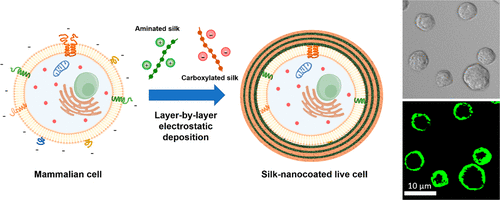当前位置:
X-MOL 学术
›
Biomacromolecules
›
论文详情
Our official English website, www.x-mol.net, welcomes your
feedback! (Note: you will need to create a separate account there.)
Synthesis and Characterization of Silk Ionomers for Layer-by-Layer Electrostatic Deposition on Individual Mammalian Cells.
Biomacromolecules ( IF 5.5 ) Pub Date : 2020-06-12 , DOI: 10.1021/acs.biomac.0c00523 Onur Hasturk 1 , Jugal Kishore Sahoo 1 , David L Kaplan 1
Biomacromolecules ( IF 5.5 ) Pub Date : 2020-06-12 , DOI: 10.1021/acs.biomac.0c00523 Onur Hasturk 1 , Jugal Kishore Sahoo 1 , David L Kaplan 1
Affiliation

|
Nanocoating of individual mammalian cells with polymer layers has been of increasing interest in biotechnology and biomedical engineering applications. Electrostatic layer-by-layer (LbL) deposition of polyelectrolytes on negatively charged cell surfaces has been utilized for cell nanocoatings using synthetic or natural polymers with a net charge at physiological conditions. Here, our previous synthesis of silk-based ionomers through modification of silk fibroin (SF) with polyglutamate (PG) and polylysine (PL) was exploited for the nanocoating of mammalian cells. SF-PL constructs were cytotoxic to mammalian cells, thus an alternative approach for the synthesis of silk ionomers through carboxylation and amination of regenerated SF chains was utilized. Through the optimization of material properties and composition of incubation buffers, silk ionomers could be electrostatically assembled on the surface of murine fibroblasts and human mesenchymal stem cells (hMSCs) to form nanoscale multilayers without significantly impairing cell viability. The resulting silk-based protein nanoshells were transient and degraded over time, allowing for cell proliferation. The strategies presented here provide a basis for the cytocompatible nanoencapsulation of mammalian cells within silk-based artificial cell walls, with potential benefits for future studies on surface engineering of mammalian cells, as well as for utility in cell therapies, 3D printing, and preservation.
中文翻译:

用于单个哺乳动物细胞上逐层静电沉积的丝离聚物的合成和表征。
用聚合物层对单个哺乳动物细胞进行纳米涂层在生物技术和生物医学工程应用中引起了越来越多的兴趣。聚电解质在带负电的细胞表面上的静电层层(LbL)沉积已被用于使用在生理条件下具有净电荷的合成或天然聚合物的细胞纳米涂层。在这里,我们之前通过用聚谷氨酸(PG)和聚赖氨酸(PL)修饰丝素蛋白(SF)合成丝基离聚物,用于哺乳动物细胞的纳米涂层。 SF-PL 构建体对哺乳动物细胞具有细胞毒性,因此采用了通过再生 SF 链的羧化和胺化来合成丝离聚物的替代方法。通过优化材料特性和孵育缓冲液的成分,丝离聚物可以静电组装在鼠成纤维细胞和人间充质干细胞(hMSC)的表面,形成纳米级多层结构,而不会显着损害细胞活力。由此产生的丝基蛋白质纳米壳是短暂的,并且会随着时间的推移而降解,从而允许细胞增殖。这里提出的策略为基于丝的人造细胞壁内的哺乳动物细胞的细胞相容性纳米封装提供了基础,对于哺乳动物细胞表面工程的未来研究以及在细胞治疗、3D打印和保存中的实用性具有潜在的益处。
更新日期:2020-07-13
中文翻译:

用于单个哺乳动物细胞上逐层静电沉积的丝离聚物的合成和表征。
用聚合物层对单个哺乳动物细胞进行纳米涂层在生物技术和生物医学工程应用中引起了越来越多的兴趣。聚电解质在带负电的细胞表面上的静电层层(LbL)沉积已被用于使用在生理条件下具有净电荷的合成或天然聚合物的细胞纳米涂层。在这里,我们之前通过用聚谷氨酸(PG)和聚赖氨酸(PL)修饰丝素蛋白(SF)合成丝基离聚物,用于哺乳动物细胞的纳米涂层。 SF-PL 构建体对哺乳动物细胞具有细胞毒性,因此采用了通过再生 SF 链的羧化和胺化来合成丝离聚物的替代方法。通过优化材料特性和孵育缓冲液的成分,丝离聚物可以静电组装在鼠成纤维细胞和人间充质干细胞(hMSC)的表面,形成纳米级多层结构,而不会显着损害细胞活力。由此产生的丝基蛋白质纳米壳是短暂的,并且会随着时间的推移而降解,从而允许细胞增殖。这里提出的策略为基于丝的人造细胞壁内的哺乳动物细胞的细胞相容性纳米封装提供了基础,对于哺乳动物细胞表面工程的未来研究以及在细胞治疗、3D打印和保存中的实用性具有潜在的益处。











































 京公网安备 11010802027423号
京公网安备 11010802027423号